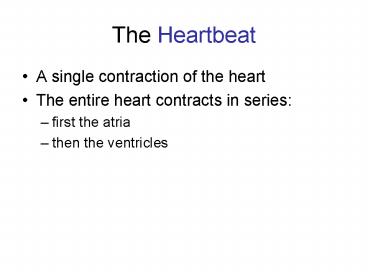The Heartbeat PowerPoint PPT Presentation
1 / 38
Title: The Heartbeat
1
The Heartbeat
- A single contraction of the heart
- The entire heart contracts in series
- first the atria
- then the ventricles
2
2 Types of Cardiac Muscle Cells
- Contractile cells
- produce contractions
- Conducting system cells
- controls and coordinates heartbeat
3
The Cardiac Cycle
- Begins with action potential
- transmitted through conducting system
- produces action potentials in cardiac muscle
cells (contractile cells)
4
What is the difference between nodal cells and
conducting cells what are the components and
functions of the conducting system of the heart?
5
The Conducting System
- A system of specialized cardiac muscle cells
- initiates and distributes electrical impulses
that stimulate contraction - Autorhythmicity
- cardiac muscle tissue contracts automatically
6
- Sinoatrial (SA) node
- pacemaker of the heart
- Atrioventricular (AV) node
- junction between the atria and ventricles
- Conducting cells
- connect the two nodes and distribute the
contractile stimulus through myocardium
7
Conducting Cells
- In the atrium
- internodal pathways
- In the ventricles
- AV bundle, bundle branches and Purkinje fibers
- Electrocardiogram (ECG/EKG)
8
The Conducting System
Figure 2012
9
- SA Node in posterior wall of right atrium
- Contains pacemaker cells
- Depolarizes first, establishing heart rate
- Connected to AV node at junction of atria and
ventricle by internodal pathways - Delays impulse atrial contraction begins
10
- AV Bundle in interventricular septum carries
impulse to left and right bundle branches - Conducts impulse to Purkinje fibers
- Distribute impulse through ventricles
- Atrial contraction is completed
- Ventricular contraction begins
11
Impulse Conduction through the Heart
Figure 2013
12
Heart Rate
- Damage to the conducting system will disrupt
normal rhythm of the heart - Damage to the SA node or internodal pathway will
result in the AV node acting as an ectopic
pacemaker - SA node generates 80100 action potentials per
minute - AV node generates 4060 action potentials per
minute
13
Abnormal Pacemaker Function
- Bradycardia
- abnormally slow heart rate
- Tachycardia
- abnormally fast heart rate
14
What events take place during an action
potential in cardiac muscle?
15
Resting Potential
- Of a ventricular cell
- about 90 mV
- Of an atrial cell
- about 80 mV
- Threshold (TMP that will cause an action
potential) is -75mV
16
- Similar to skeletal muscle in that AP leads to
Ca release which then binds to thin filament
causing contraction - Differ in nature of AP, source of Ca and
duration of contraction
17
Steps of Cardiac Contraction
- Rapid depolarization
- voltage-regulated sodium channels (fast channels)
open
18
- Plateau
- As sodium channels close
- voltage-regulated calcium channels (slow
channels) open - Na ions pumped out
- holds membrane at 0 mV plateau
19
- Repolarization
- plateau continues
- slow calcium channels close
- slow potassium channels open
- rapid repolarization restores resting potential
20
The Refractory Periods
- Absolute refractory period
- long
- cardiac muscle cells cannot respond
- Relative refractory period
- short
- response depends on degree of stimulus
21
Action Potentials in Skeletal and Cardiac Muscle
Figure 2015
22
What electrical events are associated with a
normal electrocardiogram?
23
Electrocardiogram (ECG)
- Electrical events in the cardiac cycle can be
recorded on an electrocardiogram (ECG) - Cardiac Arrhythmias
- Abnormal patterns of cardiac electrical activity
24
Typical ECG Tracing
- P wave
- atria depolarize
- QRS complex
- ventricles depolarize
- masks atrial repolarization
- T wave
- ventricles repolarize
25
The Electrocardiogram
Figure 2014b
26
What events take place during the cardiac cycle,
including atrial and ventricular systole and
diastole?
27
The Cardiac Cycle
- The period between the start of 1 heartbeat and
the beginning of the next - Includes both contraction and relaxation
- systole (contraction)
- diastole (relaxation)
28
- Atrial systole
- atrial contraction begins
- right and left AV valves are open
- Atria eject blood into ventricles filling
ventricles - Atrial systole ends
- ventricles contain maximum volume
- end-diastolic volume (EDV)
- Atrial diastole
29
- Ventricular systole
- isovolumetric contraction
- pressure in ventricles rises all valves are
closed - Ventricular ejection
- semilunar valves open and blood flows into
pulmonary and aortic trunks - Stroke volume (SV)
- Ventricular pressure falls and semilunar valves
close - End-systolic volume (ESV)
30
- Ventricular diastole
- ventricular pressure is higher than atrial
pressure - all heart valves are closed
- ventricles relax (isovolumetric relaxation)
- AV valves open and passive ventricular filling
occurs
31
What is cardiac output, and what factors
influence it?
32
Cardiodynamics
- The movement and force generated by cardiac
contractions - End-diastolic volume (EDV)
- End-systolic volume (ESV)
- Stroke volume (SV)
- SV EDV ESV
33
- Cardiac Output
- Volume pumped by each ventricle in 1 minute
- Heart rate (HR) beats/min ? Stroke volume (SV)
ml/beat - Cardiac Reserve
- resting CO - max CO
34
What variables influence stroke volume?
35
2 Factors Affect EDV
- Filling time
- duration of ventricular diastole
- Venous return
- rate of blood flow during ventricular diastole
36
3 Factors that Affect ESV
- Preload
- ventricular stretching during diastole
- Contractility
- force produced during contraction, at a given
preload - Afterload
- tension the ventricle produces to open the
semilunar valve and eject blood
37
What variables influence heart rate?
38
Factors affecting heart rate
- nervous system activity
- hormones
- drugs
- changes in ion concentration
- body temperature

